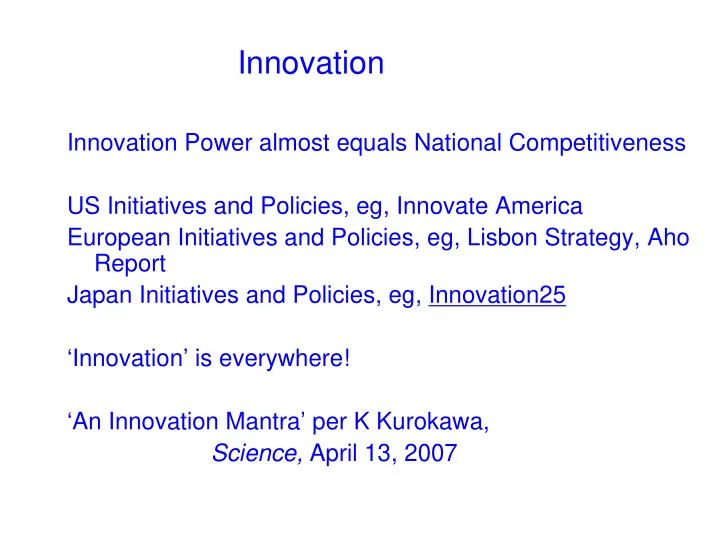

Innovation Innovation Power almost equals National Competitiveness US Initiatives and Policies, eg, Innovate America European Initiatives and Policies, eg, Lisbon Strategy, Aho Report Japan Initiatives and Policies, eg, Innovation25 ‘Innovation’ is everywhere! ‘An Innovation Mantra’ per K Kurokawa, Science, April 13, 2007
Innovation is ‘Change’, thus is against ‘Stability’
Scholarly Articles with “Innovation” in the title 1955-2004 Per 10,000 social science articles year Source: ISI Web of Knowledge, Social Science Citation Index (SSCI)
Technological Revolution and Techno-Economic Paradigm C Freeman and C Perez • First: Industrial Revolution; UK, 1771-1830 • Second: Age of Steam and Railway; UK, 1829-1873 • Third: Age of Steel, Electricity, and Heavy Engineering; US and Germany to Euro, 1875-1918 • Fourth: Age of Oil, Automobiles and Mass Production; US to Euro, 1908-1974 • Fifth: Age of Information and Telecommunication; US to Euro and Asia, 1971-20??
Fourth: Age of Oil, Automobiles and Mass Production: 1908-1974 • Mass production, mass markets, consumerism • Economies of scales (product and market volume)/ horizontal integration • Standardization of products • Energy intensity (mostly oil-based) • Synthetic materials (dyes, plastics, medicines) • Functional specialization/hierarchical pyramids • Centralization/ metropolitan centers-suburbanization • National powers, Int’l agreements and confrontation -Linear Innovation, Supply-sides dominate -National, Bi-lateral, and International -Human resource development
Innovators and Innovations • Toyota Ki-ichiro TOYOTA • Honda So-ichiro HONDA • Ibuka and Morita SONY • Ogura Masao Kuroneko Yamato • Innovative people: ones with ‘phronesis’ (Aristotle) Aspiration for true value, just and common good: Thus, driven with passion, courage and tenacity Thus, often regarded as disruptors and destructors Linear Innovation
Technological Revolution and Techno-Economic Paradigm • First: Industrial Revolution; UK, 1771-1830 • Second: Age of Steam and Railway; UK, 1829-1873 • Third: Age of Steel, Electricity, and Heavy Engineering; US and Germany to Euro, 1875-1918 • Fourth: Age of Oil, Automobiles and Mass Production; US to Euro, 1908-1974 • Fifth: Age of Information and Telecommunication; US to Euro and Asia, 1971-20?? CONSTRAINTS!!= sustainability
Constraints � Climate change/climate crisis � Environment deterioration, pollution � Water and foods and other natural resources � Perception by the general public of wide North- South disparity � Sense of inequity, frustration, violence, identity, etc, � Growing human population : 50% in last 25 years � Is Our Society Sustainable?
Innovators and Innovations • Internet: www (92); Netscape, Yahoo, Amazon (all 94); Windows95; Linux, Google (97) • Mobile phone in Japan and elsewhere, Blackberry? -Nokia, Motorola, Samsung, Sony-Erickson • Emails • iPod to iPhone- what Apple sells? • D/S, Wii- Nintendo created a new market, SONY • Technology? Regulation? Idea? Social infrastructure? • Demand-driven Innovation!
Age of Information and Telecommunication 1971-20?? • Information-intensity (microelectronics-based ICT) • Decentralized and integration / network structures • Knowledge as capital / intangible value added • Heterogeneity, diversity, adaptability • Segmentation of markets / proliferation of niches/ branding • Economies of scope and specialization combined with scale • Globalization/ interaction between the global and the local • Inward and outward cooperation/ power of clusters • Instant contact and actions/ instant global communications
Innovation in Globalized World • Invest on Human ‘Capital’ vs Human ‘Resource’ • Nurture Entrepreneurship • Heterogeneity, Diversity, Adaptability • Focus on the Strength and the Core competence • Recognize the Weakness- and Collaborate • Speed is the Essence of the Game • Think locally, Act globally International to Global !
Technological Revolution and Techno-Economic Paradigm • First: Industrial Revolution, UK, 1769-1830 • Second: Age of Steam and Railway, UK, 1829-1873 • Third: Age of Steel, Electricity, and Heavy Engineering, US and Germany to Euro, 1875-1918 • Fourth: Age of Oil, Automobiles and Mass Production, US to Euro, 1908-1974 • Fifth: Age of Information and Telecommunication, US to Euro and Asia, 1971-20?? • Sixth: Biotech, Nanotechnology? CONSTRAINTS!
The Economist Intelligence Unit, 2007 Personalization Collaboration Innovation --Japan is #1 INSEAD report, in press, Innovation index- Japan is #4
Key concepts and key words 1. ‘National, International’ to ‘Global’ 2. ‘Human resource’ to ‘Human capital’ 3. ‘Think globally, act locally’ to ‘Think locally, act globally’ 4. ‘Social entrepreneurship and Wikinomics’
Millennium Development Goals (MDGs) 8 goals Goal 1 : Eradicate Extreme Poverty and Hunger Goal 2 : Achieve Universal Primary Education Goal 3 : Promote Gender Equality and Empower Women Goal 4 : Reduce Child Mortality Goal 5 : Improve Maternal Health Goal 6 : Combat HIV / AIDS, Malaria and Other Diseases Goal 7 : Ensure Environmental Sustainability Goal 8 : Develop a Global Partnership for Development
■ you can't connect the dots looking forward; you can only connect them looking backwards. So you have to trust that the dots will somehow connect in your future. You have to trust in something — ■ You ’ ve got to find what you love. Don’t settle. ■ Death is Life ’ s change agent. => STAY HUNGRY, STAY FOOLISH! -Steve Jobs, CEO Apple & Pixar Animation At Stanford University, Commencement in 2005
Recommend
More recommend